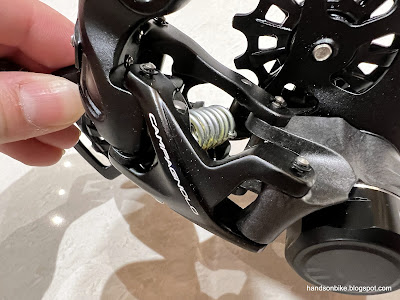Next component of the Campagnolo Ekar would be the rear derailleur. As it is a 13 speed drivetrain, the rear derailleur needs to be very well constructed and robust in order to achieve good shifting performance across all 13 gears.
In the previous posts, the Ekar shifters, brake calipers and rotors were introduced. Other components will be introduced subsequently.
13 speed rear derailleur, unique to Campagnolo Ekar
Unboxing begins
Weighs 289 grams, which is about the same weight as the GRX RD-RX815 Di2 rear derailleur.
Cheap looking barrel adjust without much indexing feeling, similar to what you find on an entry level Tourney rear derailleur.
1x B-tension screw and 2x limit screws located near to each other. It's not labeled so you need to be careful not to adjust the wrong screw.
In the manual it shows how to use the cage lock feature, to hold the derailleur in the open position for easier wheel installation and removal.
During normal operation, the button stays inside and the derailleur position is fixed.
If the rear derailleur is pulled backwards past a certain point, the cage lock engages and holds the rear derailleur in this open position. To release, push in the button that has popped out as shown above.
I think this cage lock feature is pretty useful as it makes it easier to install or remove the rear wheel. However, the mechanism feels rather flimsy due to the plastic button and other small parts which makes me wonder how durable it will be when actually used in the field.
Aluminium outer and inner links, with a large guide spring in the middle.
Cable routing is interesting as it routes along a large plastic cam that is attached to the outer link. This changes the pull ratio throughout the shifting stroke.
This aluminium cap houses the clutch mechanism inside. Not sure if it is meant to be serviceable or not.
Sticks out from the bike frame by a fair bit, as it does not have a Shadow design unlike Shimano rear derailleurs.
The support arm for the barrel adjust is a separate aluminium piece that is bolted onto the bracket member. Looks like an afterthought to me.
Large pulleys are used to help reduce the cage length. The guide pulley on top has 12 tall teeth, while the tension pulley below has 14 shorter teeth.
Cage length is 76 mm, which is considered quite short. This is possible because it is designed exclusively for front single drivetrains, so it only has to cater for the chain capacity of the cassette.
The guide pulley has an offset of 40 mm from the centre of cage rotation. This helps the pulley reach the larger sprockets at the lower gears.
The Ekar rear derailleur looks like a pretty standard mechanical rear derailleur with a traditional construction, except for the unique cage lock feature located on the bracket member. It has a traditional cable stopping point, and sticks out quite a bit with respect to the bike frame. The clutch mechanism and effectiveness is unknown yet.
In the next post, I will introduce the highlight of this groupset, which is the 13 speed Ekar cassette!

















No comments:
Post a Comment
Every comment is moderated before publishing due to spam bots. If you don't see your comment yet, it is likely that it is currently being reviewed. Thank you for your patience!